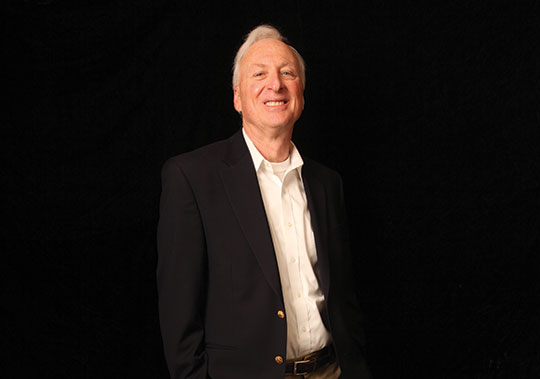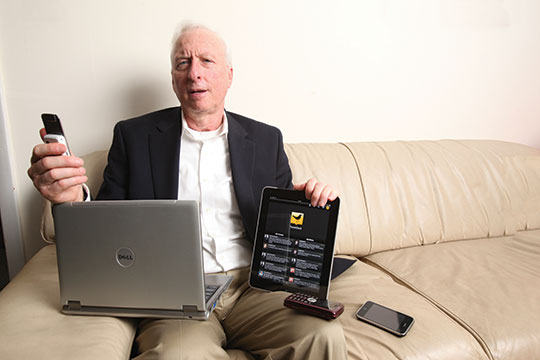Talk to Me
Rumors of psychotherapy's demise continue to be greatly exaggerated, says Barry Farber. As Woody Allen might argue: We need the eggs
Rumors of psychotherapy’s demise continue to be greatly exaggerated, says Barry Farber. As Woody Allen might argue: We need the eggs
By EMILY ROSENBAUM
Photography by Bruce Gilbert
PSYCHOANALYTICALLY ORIENTED PSYCHOTHERAPY, more commonly known as “talk therapy,” has existed in the formal sense for only a little more than a century. But in that time it has faced some stiff challenges, including pharmacological treatments, cognitive behavioral therapy, managed-care restrictions and rebellion against the therapist’s authority and neutrality. And now, in the age of Facebook, Twitter and ever-shorter attention spans, comes a challenge from communications technology, too.
For Barry Farber, Professor of Psychology and Education, a central factor in how the practice has responded—and, ultimately, a major reason why it has survived—has to do with disclosure.
“Even in psychotherapy there’s this dialectic between, on the one hand, wanting to confess and let the therapist know everything, and on the other, avoiding shame,” says Farber, the author of Self-Disclosure in Psychotherapy (Guilford, 2006). “Most people struggle to tell their therapist everything, even though they say they want to.” Understanding the gap between what patients want to share and what they actually share can help therapists strengthen the therapeutic relationship. Farber has also examined the flip side: what therapists tell their patients about themselves.
Psychoanalytically oriented or psychodynamic therapy is what most people think of when they talk about “traditional” therapy, in which the patient works through his or her issues by talking with a therapist. Through the 1960s, this form of therapy held what Farber terms a “near monopoly,” but that changed in the 1970s with the rise of cognitive behavioral therapy (CBT), which targets specific behaviors and aims for concrete outcomes. The “why” of a person’s problematic behavior is less central in CBT, except in the more immediate sense of focusing on motivations that can be blunted or used as incentives. The patient spends less time unburdening and more time simply trying to modify behavior. In the 1970s and 1980s, CBT “seemed to turn on a firmer foundation,” says Farber. “The American Psychological Association was pushing clinical psychology to rest on a more scientific basis, and Ph.D. programs were moving toward a greater emphasis on science than on practice.”
Then, too, Farber says, in the 1980s and 1990s, CBT became very attractive to insurance companies and HMOs, which wanted faster, cheaper fixes and were “very unhappy about the long-term, almost interminable length of time that analytically oriented therapies were taking.” The insurers also wanted “greater specification of technique, aims, problem formation and results.”
Hence the concomitant rise of medication, beginning with drugs such as Miltown and continuing with the subsequent introduction of more sophisticated treatments such as Prozac, which modify the uptake of serotonin, dopamine and other brain chemicals. Medications have now been approved for a host of newly identified anxiety- and depression-related disorders, as well as for more serious psychotic illnesses, and constitute a booming business.
Yet, as Farber points out, medication works in only about two-thirds of patients and often has serious side effects. Perhaps even more to the point, both medication and CBT lack the critical component of disclosure.
“While CBT is still by far the prevailing modality, psychoanalytically oriented psychotherapies are far from dead and in fact are making a nice comeback,” Farber says. “People do not want just symptom relief from their psychotherapy. There are a fair number of people who want meaning in their lives, who are looking for their therapy to answer some existential questions or some interpersonal questions. It’s not about symptom relief to ask, ‘How can I get a greater sense of self?’ or ’How can I get along better with the important people in my life?’”
True, existential questions are not quantifiable, and insurance companies don’t have a treatment code for them. But Farber points out that psychoanalytically oriented psychotherapy, too, has a basis in science. There have been a number of articles asserting the efficacy of psychodynamic therapy. Farber points to a 2010 review of research in The American Psychologist by Jonathan Shedler, “The Efficacy of Psychodynamic Psychotherapy,” which finds that psychodynamic therapy has longer-lasting results than therapy aimed only at changing behavior, possibly because psychodynamic therapy helps build “inner capacities” that strengthen a patient beyond symptom relief.
“The assumption that cognitive behavioral therapy should be the preferred modality because it’s more effective turns out to be untrue,” Farber says. “If you reanalyze the data, there’s no reason for psychoanalytically oriented psychotherapists to take a backseat or be ashamed of the scientific results.”
In addition, psychoanalytic therapy has evolved, taking “a more relational turn” during the past 30 years, explains Farber. It’s not about epiphany or a one-sided disclosure, but rather about a relationship between therapist and patient. “People now talk about ‘contemporary relational dynamic psychotherapy,’ in which the relationship with the therapist provides the template for how one looks at other relationships in life, and there’s far more interaction between the patient and his or her therapist.” Within this relationship, patients and therapists together do the work of making meaning.
That sense of connection may be all the more important in the current economic climate, Farber says. “Not having a job is first and foremost an economic problem, but it has psychological consequences. It impairs people’s sense of self.” Of course, paying for psychoanalytic therapy can be tough for those without health insurance, as well as for people whose managed-care providers will cover only a few dozen therapeutic sessions. But many therapists will continue therapy at greatly reduced rates when the insurer stops covering treatment. For patients without coverage, there are sliding-scale clinics and student-run facilities, such as those at the analytic institutes and many colleges and universities, including Teachers College.
Now, though, psychotherapy is facing a new challenge. Do people still seek long-term analytical relationships in the age of Facebook? The psychoanalytic “hour” has already been chopped to 50 or even 45 minutes. So is there a place for talk therapy at a time when all a person needs is a WordPress account to unburden herself of her deepest secrets?
Absolutely, says Farber, whose most recent research delves into how young adults are using social media to disclose and ways such disclosure affects and is affected by the therapeutic relationship.
Sharing via social media has become an almost continuous process in so many people’s lives, but as Farber’s research finds, the process of disclosure in blogging and tweeting just doesn’t have the same effect as it does in psychodynamic therapy. Certainly there are benefits to using technology to discuss troubling aspects of one’s life. For example, many adult survivors of childhood sexual abuse find support in an online community. “It does have the elements of a group therapy experience, of people providing some sense that what you’re feeling makes sense, what you’re feeling is normative, and perhaps most important, it wasn’t your fault.” However, this online experience is very different from having an effective therapeutic relationship.
“There’s a cathartic effect with online disclosure in relieving yourself of the burden of something that you want to get off your chest,” Farber explains. But “after the moment’s relief, it leaves you feeling raw and thinking, ‘Now what do I do with this stuff?’ which is where the real therapist is better than tweeting or putting it out in the blogosphere.”
Shame may be even more of an issue for a person who unburdens via social media. At least in face-to-face talk therapy, “the therapist and you now have an opportunity of speaking through your shame and wondering where it came from and how it manifests in other situations,” Farber says. “It can be a learning moment. That kind of reparative work is very unlikely to happen through social media. You’re stuck with the shame.”
Certainly it is easier and cheaper to tweet every time one feels down. But Farber believes that, as preceding generations have discovered, there is no substitute for talking about issues with someone who’s expert in the process.
“I believe in therapy,” he says. “I believe therapists are beyond even the most intimate, loving friends. The therapist provides an interpersonal opportunity to rework the narrative, to tell the details of the story, but ultimately in a different way.” This is something you just can’t do in 140 characters.
Published Wednesday, Dec. 14, 2011

